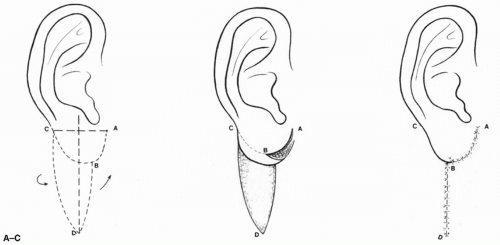Lateral Neck Skin Flap for Earlobe Reconstruction
S. ZENTENO ALANIS
FLAP DESIGN AND DIMENSIONS
The size and shape of the opposite earlobe are used as the model for the earlobe being reconstructed. The flap design is shown in Figure 95.1. A line is drawn from point A (site of earlobe implantation) to point B (the most inferior point of the lobe) and from point A to point C (the most posterior point of the transverse diameter of the lobe). From points B and C, a vertical flap is traced downward, perpendicular to the line AC. Line BD should be equal in length to line AB and line CD to line CA. The flap should be made 1 to 2 mm larger than desired to compensate for retraction of the tissue after it is incised. The incisions will follow the line ABDC.
OPERATIVE TECHNIQUE
The earlobe reconstruction may be achieved in one surgical procedure with the patient under local anesthesia (Fig. 95.2). The skin from the adjacent lateral neck is used because it possesses characteristics similar to earlobe skin. The flap is dissected to include the subcutaneous tissue, and it is detached up to the projection of the line AC (Figs. 95.1 and 95.3B). Following this, the tip D of the flap is taken to point A, where it is fixed by a transfixion suture (Figs. 95.1 and 95.2C). The flap BDC is placed in such a way that it will provide the posterior cover of the earlobe by suturing the edge BD to BA with 5-0 or 6-0 nylon. Interrupted sutures fix the posterior edge of the flap (line CD) to the depth of the projected line (AC).
Stay updated, free articles. Join our Telegram channel

Full access? Get Clinical Tree









